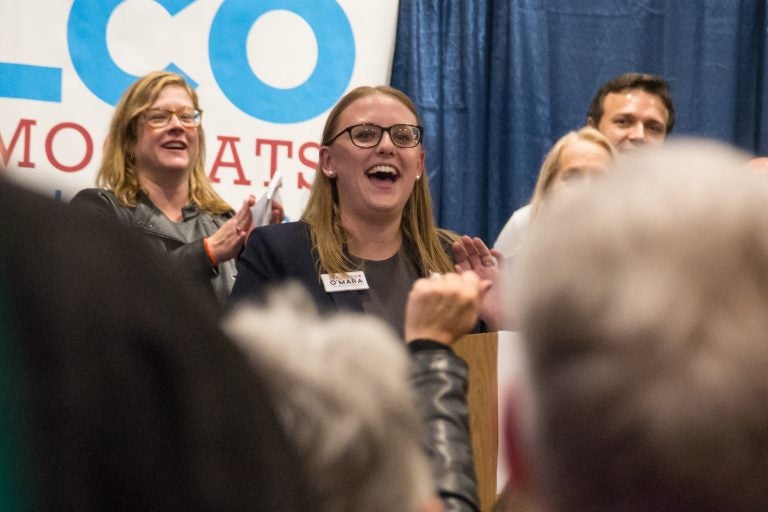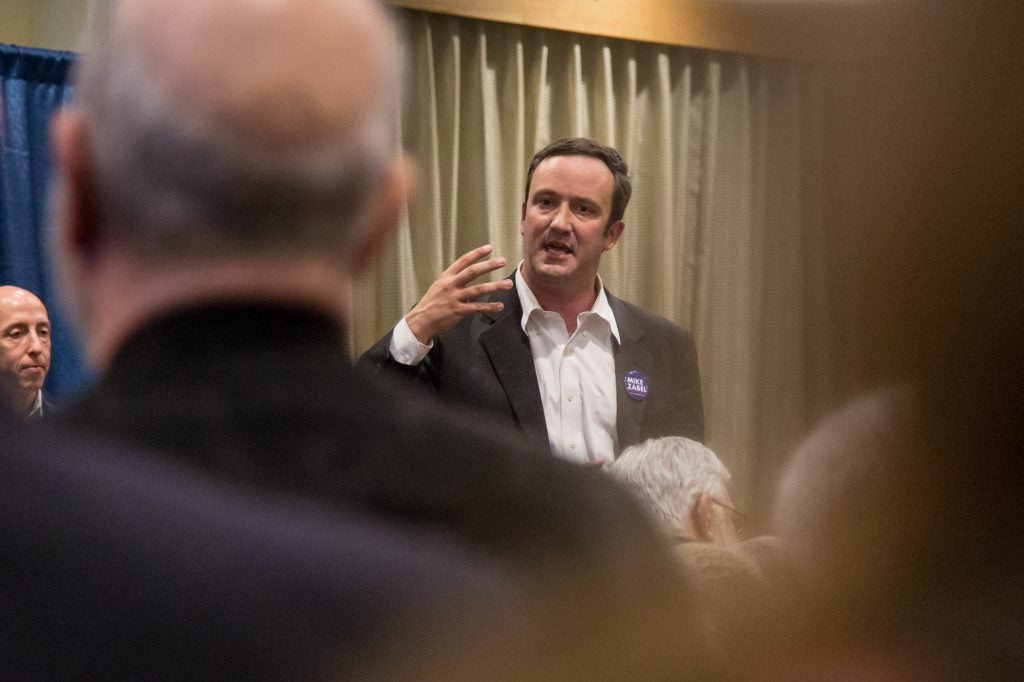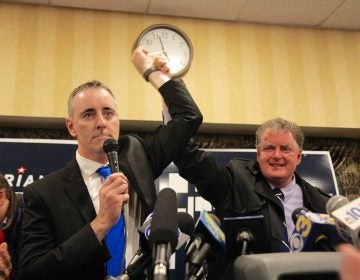Surge in Philly suburbs brings Democrats gains in Harrisburg, but GOP holds General Assembly

Democrat Jennifer O'Mara is met with joyous celebration after winning a Statehouse race Philadelphia's suburbs. (Emily Cohen for WHYY)
The wake of the blue wave that swept Democrats into control of the U.S. House of Representatives trickled down to Pennsylvania state legislative races, but wasn’t powerful enough to upend GOP control of the General Assembly.
All 203 seats in the state House of Representatives and 25 of the 50 state Senate seats were up for grabs Tuesday. With a handful of races in both chambers still too close to call, the GOP majorities in both chambers have diminished, in large part due to strong Democratic performance in the Philadelphia suburbs.
Heading into the election, Republicans held a commanding 33-16 majority in the Senate, with one vacancy. Democrats reduced the spread considerably on Tuesday: the count now stands at 28 Republicans and 21 Democrats, with one race still too close to call.
The breakdown of the state House before the election was 120 Republicans, 81 Democrats, and two vacancies (one Democrat and one Republican). Now there are 105 Republicans, 94 Democrats, one vacancy and three races still too close to call, according to the unofficial counts as of Wednesday afternoon.
With Gov. Tom Wolf’s re-election, these legislative results ensure Pennsylvania will continue to have divided government for at least another two years.
Here are some highlights and takeaways from Tuesday.
Presidential impact
Stumping for Republicans in congressional and gubernatorial races this year, Trump repeatedly described these midterms as a referendum on his presidency.
“Even though I’m not on the ballot, in a certain way I am on the ballot,” he reiterated to reporters Monday.
While races for the state legislature are normally parochial in nature — and far removed from the political machinations in Washington, D.C. — that isolation often does little good for candidates in midterm elections. The penalty against the party in the White House usually extends to statehouses.
This year appeared to be no different. As predicted, Pennsylvania House Democrats made large gains in the relatively wealthy Philadelphia suburbs, while Republicans made smaller advances in the Rust Belt towns surrounding Pittsburgh where working-class white voters have embraced GOP populism.
In 2016, Republicans won 19 Statehouse districts that also went for Hillary Clinton; Democrats took 17 districts that voted for Trump. This year, Republicans ousted Democrats in four of those Trump-voting House districts, while Democrats took 11 GOP-held seats in districts that backed Clinton — all in Southeast Pennsylvania.
Delaware County, once home to a formidable Republican machine, broke heavily for Democrats. Democrat David Delloso edged out Mary Hopper for the open HD-161 seat, vacated by Rep. Nick Miccarelli, who was forced to retire in the wake of sexual assault allegations. In the 163rd, two-term incumbent Republican Jamie Santora was ousted by attorney Mike Zabel. Like most of Delaware County, both districts narrowly went for Clinton in 2016, reflecting a long, slow shift towards the Democratic party in Philly’s suburbs.

In the Senate, Democrats took six Clinton-backing districts previously held by Republicans.
That number may increase to seven. In Bucks County, GOP incumbent Robert “Tommy” Tomlinson has a 100-vote lead on Rep. Tina Davis in the 6th District. This hard-fought race in Lower Bucks will likely go to a recount.
In the interactive map below, created by Azavea, you can see results in all of Tuesday’s legislative races.
Note that only half of the State Senate had an election, so for districts where there was not a contest, the map is colored by the party that currently holds the district.
More tight races
In Southwest Pennsylvania’s 49th District, GOP Rep. Bud Cook has just 94 votes over challenger Steven Toprani. In the 105th, Republican Andrew Lewis holds a 522-vote lead over Eric Epstein for the Dauphin County seat opened by the retirement of GOP Rep. Ron Marsico. In the 166th, Democrat Jennifer O’Mara leads incumbent Rep. Alexander Charlton by 163 votes in this Delaware County district.
And there’s still one race for voters to decide. Democratic Rep. Michael Kavulich passed away suddenly in October, and a special election is planned to pick his replacement. While Kavulich won his district handily in 2016, it also voted for President Donald Trump in 2016. Wolf hasn’t set a date for the special election, although the 2019 primary date, May 21, is a likely option.
Can’t win races if you don’t run
Democrats managed to field candidates in significantly more races than in recent history, while Republicans did so in less.
Many first-time Democratic candidates cited the 2016 election as the impetus for their campaigns.
Republicans gifted Democrats 55 state House districts this year – including seven that voted for Trump in 2016 – a slight uptick from the 47 districts it challenged in 2016. Democrats returned the favor in just 24 districts this year, significantly fewer than the 51 where the GOP ran unopposed in 2016.
Similarly, in the state Senate, Democrats fielded challengers in all but one race, whereas Republicans let five seats go without a fight. In 2014, five Republicans and four Democrats ran unopposed for state Senate seats.
While failing to contest races can indicate a feckless party, the decision to concede the field can make sense in some instances. In some Pennsylvania legislative districts, one party so vastly outnumbers the other that a challenge would be nearly impossible. But, this year, Republicans chose not to fight for districts that voted for Trump – including HD-55 in Westmoreland County and HD-123 in Schuylkill County, where Trump won with more than 60 percent of the vote. This gave Democrats some easy wins.
Year of the woman?
This year, a record number of Pennsylvania women ran for state offices and Congress. Collectively, they sought to invert the Keystone State’s relatively low level of female electoral representation. Heading into the election, just 45 women served in the House and only seven in the Senate.
The Senate added at least five women this year, bringing the total to 11. Two big Senate wins had Democrats Lindsey Williams defeating Jeremy Shaffer in Allegheny County and Katie Muth unseating John Rafferty in Philadelphia’s suburbs. A sixth woman could join as well, if Tomlinson’s razor-thin edge over Tina Davis in Lower Bucks doesn’t hold.
The number of women state representatives will increase to at least 49 — if Jennifer O’Mara’s slight lead in Delaware County’s 165th is confirmed as a win, there will be 50.
Democrats big dreams dashed
Democrats hoped to pick off a trio of big targets during the campaign. Polls showed House Speaker Mike Turzai, R-Allegheny, and Senate Majority Leader Jake Corman, R-Centre, within striking distance by their opponents. Outspokenly homophobic state Rep. Daryl Metcalfe, R-Butler, faced a strong challenge from an openly gay Democrat.
In the end, none of those races panned out for the challengers. Corman’s opponent, Ezra Nanes, emphasized the Senate’s inability to pass a bill granting victims of sexual assault a two-year window to file civil lawsuits for crimes where the statute of limitations has lapsed. But Corman didn’t flinch, responding with an ad featuring Sue Paterno, the widow of Penn State coach Joe Paterno, who praised the Republican for defending Paterno in the wake of the Penn State sex abuse scandal.
Internal polls showed Turzai in a close race against challenger Emily Skopov. In the end,Turzai held on by a comfortable nine points.
The outcome was more certain the 12th Legislative District, where Metcalfe cruised to a 58-42 percent victory over Democrat Daniel Smith. While that margin was significantly smaller than Metcalfe’s victory in 2016, Smith’s strong run, and Metcalfe’s poor relationship with fellow Republicans, wasn’t enough to remove the 10-term incumbent in a district where 67 percent of voters backed Trump in 2016.
Senate Appropriations Chairman Pat Browne, R-Lehigh, also faced stiff competition Tuesday, but eked out a win.
Nepotism
Tuesday was a bad night for junior.
Three sons sought to follow their fathers’ footsteps on Election Day, seeking seats last held by their retiring dads. In the Senate, Stewart Greenleaf Jr. tried to keep Montgomery County’s 12th District in the family name. His father, Stewart Sr., was the longest-serving legislator in Harrisburg and a prolific legislator who went from a tough-on-crime prosecutor to a crusading criminal-justice reformer, a Republican pushing for progressive changes. Montgomery County voters declined, though, opting instead for Democrat Maria Collett.
In the House, Democrats Brandon Markosek and Michael Hanna Jr. also tried to keep the same surname representing the 25th and 76th Districts, respectively.
Hanna Jr. fell to Republican Stephanie Borowicz in the 76th — a race that was surprisingly close for a district Trump won by 40 points. But Markosek cruised to a comfortable win against Republican Stephen Schlauch in Allegheny County.
Other notes
Republican Harry Lewis Jr., the only black member of the GOP caucus in Harrisburg, won Coatesville’s HD-74 in a squeaker last go around, but recently decided to retire. Amber Little Turner, an African-American aide to Lewis, tried to take his place, but fell well short of Dan Williams in this Democrat-heavy district.
Martina White is now the lone Republican in Philadelphia’s state house delegation. White won her re-election in Northeast Philadelphia’s 170th by a 58-42 percent margin, while the race to replace retiring GOP Rep. John Taylor in the 177th went to Democrat Joe Hohenstein. Despite White’s opposition to Philadelphia’s sanctuary city status — a popular position in her blue-collar district — sources say city Democrats weren’t excited by the prospect of knocking her out of office, realizing they’d lose an important voice in the GOP caucus, which continues to control the legislative branch in Harrisburg.
WHYY is your source for fact-based, in-depth journalism and information. As a nonprofit organization, we rely on financial support from readers like you. Please give today.





